Asus TUF X470-Plus Gaming Review: Attractive Value
Why you can trust Tom's Hardware
Overclocking & Verdict
Overclocking
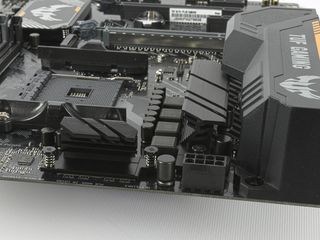
As we mentioned in the product overview, the Tuf X470-Plus Gaming doesn’t appear to be a good overclocking performer--at least on the surface. Fortunately, the Asus UEFI is a great asset for builders, and all of the options we typically see in higher-end boards are enabled for us to potentially push this 6-phase board to the edge. If you'v followed overclocking results on other AM4 chipsets, you'll know roughly the same overall overclocks are achievable from any of the available regulator designs.
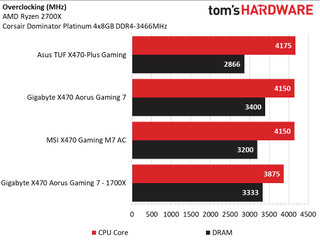
With all that said, we start our overclock search with a modest 40.0 multiplier on all cores, and observe stable runs through Prime95. Pushing forward, 40.5 and 41.0 also show stable results without adjusting any additional settings. Bumping to 41.25 requires a load line change to “high,” thus reducing voltage droops as the power virus cycles states. We also observe the voltage VID and sense voltage through HWiNFO64 to increase as we overclock. So we are still in safe and acceptable boundaries. 4.15GHz runs fine for 30-minute runs of Prime95l, and we finally hit the wall at 4.2GHz.
At that frequency, we were able to boot and run AIDA64’s FPU stress test for 30 minutes with temperatures hovering in the upper 80’s C. However, our charts require 8-hour-long Prime95 runs, so we ended up with an impresssive 4175MHz at roughly 1.365V Vcore, according to HWiNFO. Processor temps were acceptable, though more aggressive overclockers should be cautious in pushing the system further. At these settings our Vreg heatsinks were starting to reach 131 C, so you'll want to pick a board with higher phase counts and bigger heatsinks for prolonged overclocks maximum.
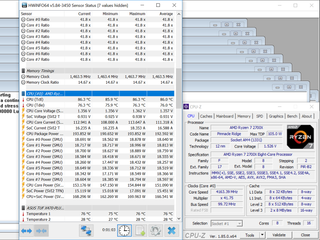
Since we're now equipped with a DDR4-3466 memory kit, we were hoping to see some impressive results when it comes to RAM settings. Unfortunately, the XMP profile for 3466MHz refused to load. That may be typical, but we also couldn't get DDR4-3200MHz to work in our fully populated configuration. Continuing to step down, DDR4-3000 wasn't bootable, and DDR4-2933 was only stable for about 3 minutes of AIDA64’s memory stress test. From here, we can either live with DDR4-2866, or adjust the SoC load line to High to reach 2933. On the bright side, most builders who opt for this TUF Alliance board will opt for only 2 DIMMs in their system. That configuration should allow for higher memory overclock rates.
Conclusion
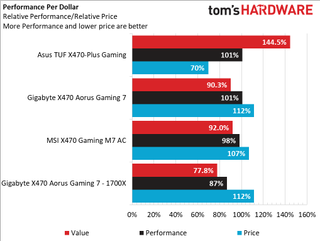
Coming in at $150 at the time of writing, this board clearly wins the value award compared to the other premium boards we’ve tested. As a value-targeted board, it succeeds in areas that our previous-generation Biostar X370 GT7 board didn't. Asus delivers a a well-rounded mainstream board with enough performance and polish to compete in this crowded budget board space.
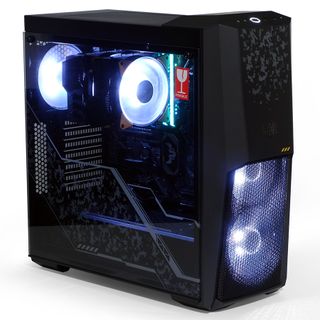
However, as a standalone X470 board, the Asus TUF X470-Plus Gaming ditches some features we've come to expect from an enthusiast-targeted chipset. Sure, our overclocking was successful. But we hope that people won’t attempt to run the settings we achieved as 24x7 overclocks, because of potential thermal issuees. If you want to push your CPU to the limit, you should opt for something with more robust power delivery and beefier coolers.
Even the system's IO left us scratching our heads. Wiring out the PCIe Gen3 to strictly connect to the top slot is a good move for simplicity's sake, but some builders might want to plug in more bandwidth-heavy secondary cards in the future. To those potential buyers, we’d recommend using a different board.
Now let’s think of the TUF Alliance and gaming. This board is designed specifically to be paired with other TUF componens, and we think it hits all the right marks for a great base-level gaming rig. ESports enthusiasts tend to emphasize performance, aesthetics, and value. And the Asus TUF X470-Plus Gaming checks all those boxes.
MORE: Best Motherboards
MORE: How To Choose A Motherboard
MORE: All Motherboard Content
Stay on the Cutting Edge
Join the experts who read Tom's Hardware for the inside track on enthusiast PC tech news — and have for over 25 years. We'll send breaking news and in-depth reviews of CPUs, GPUs, AI, maker hardware and more straight to your inbox.
-
Soda-88 So you're telling me that a motherboard with far more inefficient VRM due to lack of phases (31W higher consumption than Gaming 7 in Prime/Furmark) is a good overclocking board? Have you measured the VRM temperatures at all?Reply
This motherboard is a ticking timebomb if you plan on running 8 core CPU at high utilization.
Another thing regarding this motherboard in particular is that it shares the same VRM design with $75 ASUS motherboards (with addition of better capacitors, which in no way redeems the inadequacy of VRM in general).
Prime X470 Pro VRM is quite significantly better (it's the same VRM as on Strix SKUs) and it comes at nearly the same price.
For more info watch this:
https://www.youtube.com/watch?v=pq0MLtjFS1A -
Calculatron I'm not sure how I feel about the TUF brand being re-purposed like this. I'm sure that it made sense to ASUS to use an existing, and popular, type of branding to cover a market segment. The marketing and accounting departments probably thought it was a win, and no doubt profits will reflect that. Let us hope that, in the future, there is room to create a class of no-nonsense overclocking boards.Reply -
TheTerk Reply
I don't know if you're trolling me, but I clearly state this in the overclocking section....21177573 said:So you're telling me that a motherboard with far more inefficient VRM due to lack of phases (31W higher consumption than Gaming 7 in Prime/Furmark) is a good overclocking board? Have you measured the VRM temperatures at all?
This motherboard is a ticking timebomb if you plan on running 8 core CPU at high utilization.
Another thing regarding this motherboard in particular is that it shares the same VRM design with $75 ASUS motherboards (with addition of better capacitors, which in no way redeems the inadequacy of VRM in general).
Prime X470 Pro VRM is quite significantly better (it's the same VRM as on Strix SKUs) and it comes at nearly the same price.
For more info watch this:
https://www.youtube.com/watch?v=pq0MLtjFS1A
At these settings our Vreg heatsinks were starting to reach 131 C, so you'll want to pick a board with higher phase counts and bigger heatsinks for prolonged overclocks.
-
Anheanz I purchased this mobo from my local Microcenter and it was DOA. It was promptly replaced with a Gigabyte x470 gaming 5Reply -
jpe1701 It seems like the vrms on the AMD boards are worse than Intel. At least the mid range and down anyways. I have the x370 taichi and the quality is fantastic though, the only thing lacking is the new agesa code bios update hasn't been released yet. All the other Asrock am4 motherboards have it.Reply
